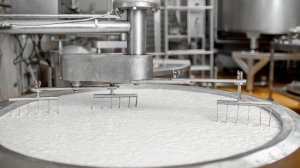Innovations in processing improve food safety



RENEWING OLD INNOVATION The newest application of fermentation has been the production of cultured, or cell-based, and mycelial protein products, alleviating the pressure on large-scale animal husbandry to produce enough animal protein, ensuring food safety
Photo by Verder
REFRIGERATION UNNEEDED By filling sterilised containers in a sterile environment with a sterilised product, aseptic processing and packaging removes the need for refrigeration and results in improvements in shelf stability
Photo by Verder
With the world still adapting to post-pandemic consumer demand for “farm-to-plate freshness”, variety and convenience, pumps manufacturer Verder notes there are two factors that continue to drive innovation in food technology: the need for safe and shelf-stable food.
“These drivers are further fuelled by the need to achieve environmentally sustainable production facilities, and contribute to company, sector and national carbon reduction targets and net-zero objectives, while remaining profitable,” says Verder hygienic pump specialist Eddie le Roux.
He highlights, “to achieve all this, the food manufacturing industry must continue to seek out innovative processing operations”.
The challenges of population growth, climate change, and shifting consumer demand puts technological innovations at the forefront of sustainable food processing.
Consequently, there are three key innovations that are replacing heat and chemicals to keep food fresh and safe, while shaping the future of processing.
“The first is high-pressure processing, which rapidly kills vegetative microbes and inactive viruses while denaturing enzymes that can cause food to spoil,” explains Le Roux.
This batch process applies high pressures of as much as 100 000 psi after packaging, minimising food treatment time and preserving nutrition and flavour.
The second is fermentation, which, while it is one of the oldest food preservation processes, is another area where innovative technologies can improve sterility, prevent cross-contamination and ensure sustainability.
Le Roux points out, “the newest application of fermentation is the production of cultured, or cell-based, and mycelial protein products, which alleviate the pressure on large-scale animal husbandry to produce enough animal protein to ensure food security”.
These alternative protein production technologies also reduce greenhouse-gas emissions.
Le Roux elaborates, noting that although this is not ‘mainstream’ yet, sterility is paramount in food production facilities, where clean-in-place (CIP) and sterilisation-in-place (SIP) are crucial.
The third is aseptic processing and packaging, that removes the need for refrigeration during transport, and in stores, for a variety of animal and plant-based products, such as liquid eggs, soup, purees and more.
Filling sterilised containers, in a sterile environment, with product that has been sterilised has resulted in improvements in shelf stability.
Le Roux notes that this kills microbes in the food and prevents these microbes from being reintroduced during packaging.
“Pumping solutions are often overlooked as an opportunity for improved shelf stability, cost reduction and [enhanced] production capacity. But they are integral to every industrial processing facility,” he asserts.
In the case of high-pressure processing, the “right” high-pressure or hygienic pumping solutions are also crucial to food safety.
First and foremost, the pumping solution cleanability requirements must be designed to meet international and local hygiene standards – including CIP and SIP – as these can present many challenges for processors.
“This is where hygienic pumps with a modular design can be integrated, allowing for streamlined disassembly, cleanability and reassembly,” Le Roux adds.
A particular risk in fermentation processing facilities is cross-contamination. Le Roux explains that it can be mitigated against through careful equipment selection.
Fit-for-purpose hygienic pumping solutions that have been designed to eliminate any risk of contaminants are necessary for producers that want to stay ahead of the advances in fermentation technology.
Le Roux reiterates that “as the food and beverages industry continues to evolve to ensure that food is safe, shelf-stable and tasty, manufacturers must ensure their processes are reliable, repeatable and error-free”.
Integrating the right equipment is critical to food safety and sustainable production, as the technical aspects of selecting the right pumping solutions for specific applications can be complex.
Le Roux concludes that food and beverage processors should, therefore, look to a trusted and reputable brand that can provide solutions that are long-lasting, cost-effective and efficient.
Article Enquiry
Email Article
Save Article
Feedback
To advertise email advertising@creamermedia.co.za or click here
Comments
Announcements
What's On
Subscribe to improve your user experience...
Option 1 (equivalent of R125 a month):
Receive a weekly copy of Creamer Media's Engineering News & Mining Weekly magazine
(print copy for those in South Africa and e-magazine for those outside of South Africa)
Receive daily email newsletters
Access to full search results
Access archive of magazine back copies
Access to Projects in Progress
Access to ONE Research Report of your choice in PDF format
Option 2 (equivalent of R375 a month):
All benefits from Option 1
PLUS
Access to Creamer Media's Research Channel Africa for ALL Research Reports, in PDF format, on various industrial and mining sectors
including Electricity; Water; Energy Transition; Hydrogen; Roads, Rail and Ports; Coal; Gold; Platinum; Battery Metals; etc.
Already a subscriber?
Forgotten your password?
Receive weekly copy of Creamer Media's Engineering News & Mining Weekly magazine (print copy for those in South Africa and e-magazine for those outside of South Africa)
➕
Recieve daily email newsletters
➕
Access to full search results
➕
Access archive of magazine back copies
➕
Access to Projects in Progress
➕
Access to ONE Research Report of your choice in PDF format
RESEARCH CHANNEL AFRICA
R4500 (equivalent of R375 a month)
SUBSCRIBEAll benefits from Option 1
➕
Access to Creamer Media's Research Channel Africa for ALL Research Reports on various industrial and mining sectors, in PDF format, including on:
Electricity
➕
Water
➕
Energy Transition
➕
Hydrogen
➕
Roads, Rail and Ports
➕
Coal
➕
Gold
➕
Platinum
➕
Battery Metals
➕
etc.
Receive all benefits from Option 1 or Option 2 delivered to numerous people at your company
➕
Multiple User names and Passwords for simultaneous log-ins
➕
Intranet integration access to all in your organisation


















